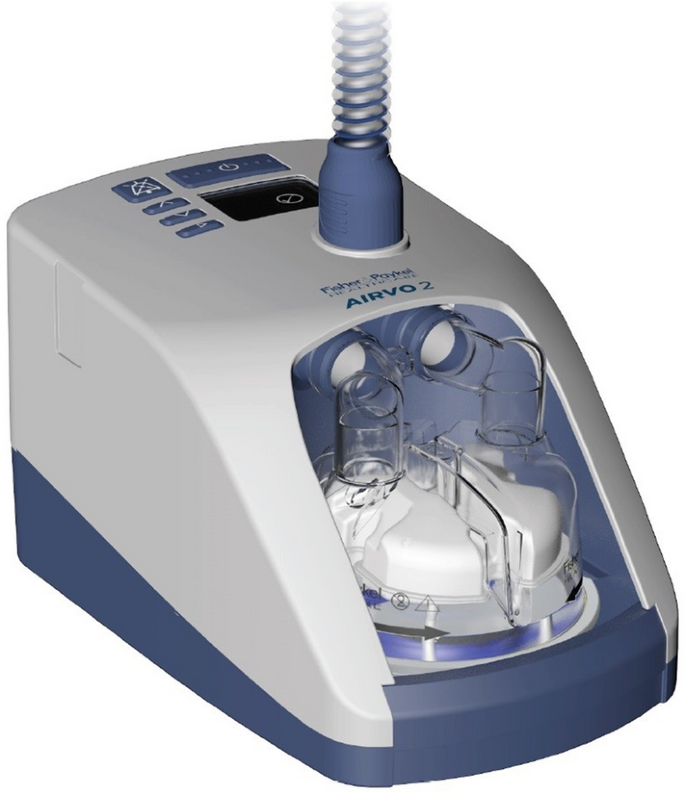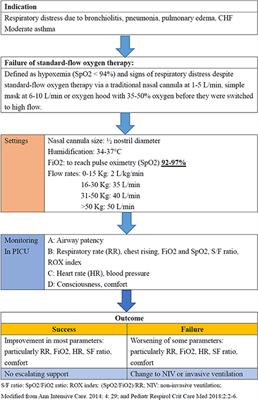heated high flow oxygen levels
Fraction of inspired oxygen FiO2 of 21 to 98 relative humidity of 95 to 100 a flow rate of 15 to 60 Lminute. Heated humidified high-flow HHHF therapy often also high flow nasal cannulae HFNC or high flow nasal oxygen HFNO is a type of respiratory support method that delivers a high flow liters per minute of medical gas to a patient through an interface nasal cannulae intended to create a wash-out of the upper airwayThe applied gas is heated to best match human body.

High Flow Nasal Cannula Youtube
Over the past 2 decades systems to deliver heated and humidified oxygen at high flows through nasal cannulae have been developed as an alternative to standard oxygen delivery systems.

. Although there is no clear standard as to what constitutes a high level of PEEP a conventional threshold is 10 cm H 2 O. The device consists of an airoxygen blender connected through an active heated humidifier to the nasal cannula and allows adjustment of the F io2 independently from the flow rate. The flow rate is how many liters of oxygen per minute your device delivers.
The low-flow nasal cannula is an open system of supplementation with high levels of leaking air around the oxygen source. Use minimal flow to maintain SpO2 greater than 88 to 94. Heated High Flow Oxygen using OptiFlow system at UIHC UIHC currently utilizes Fisher Paykels OptiFlow system to deliver Heated High Flow Oxygen Therapy This system is approved for use in the following areas.
There are three main proposed benefits of HFNC. First High Flow Oxygen Therapy HFOT is an oxygen delivery system which provides heated humidity with high flow levels of oxygen O2. The device can deliver.
Over the past 2 decades systems to deliver heated and humidifi ed oxygen at high fl ows through nasal cannulae have been developed as an alternative to standard oxygen delivery systems. This includes a high-flow nasal cannula a high-flow source with systems regulating the flow and the FiO 2 a humidifier system and heated tubing. An explorative study was undertaken using retrospective chart review to identify characteristics of adult patients who received HHHFNO in a tertiary adult ED between January.
17 Recent reports have suggested that. Discussion The normal human body temperature is 365-375C 2. COPD patients may be prescribed oxygen therapy if the level of oxygen in their bloodstream is too low.
A high-flow nasal cannula HFNC delivers a flow rate up to 8 Lmin in infants and 60 Lmin in adults. The expected benefits of HFNO depend on its indication and the device to which HFNO is compared Table 1To date the use of HFNO has been suggested in several indications but few have been rigorously evaluated Table 2The two primary indications in terms of level of evidence are 1 to prevent. We started treatment with heated high-flow nasal oxygen Optiflow with a surprising improvement of cutaneous temperature until 36C and beneficial effects on her general clinical conditions.
In recent years nasal cannulae designed to administer heated and humidified airoxygen mixtures at high flows up to 60 Lmin have been gaining popularity. In addition high flow oxygen therapy ensures high FiO2. As such the efficacy of treatment for the low-flow nasal cannula is limited.
HFNC provides good patient comfort through heated and humidified gas flow delivered via nasal prongs at a steady rate. The aim of this study was to determine the role that heated humidified high-flow nasal oxygen HHHFNO plays in the adult ED with particular focus on the indications and outcomes of use. Such conventional systems do not deliver a reliable fraction of inspired oxygen and are generally poorly tolerated for prolonged periods due to inadequate warming and humidification of inspired gas.
Traditional oxygen delivery systems do not exceed 16 Lmin while HFOT can deliver up to 60 Lmin and as high as 100 oxygen Lindenauer et al 2014. Frat JP Thille AW Mercat A et al. Recently growing attention has been paid to an alternative to conventional oxygen therapy.
High-flow Nasal cannula consists of a specific machine and tubing used to deliver a very high flow of oxygen that is heated and humidified. High-flow nasal cannula HFNC therapy is an oxygen supply system capable of delivering up to 100 humidified and heated oxygen at a flow rate of. For example patients commonly use a flow rate of 2 liters per minute but the flow rate varies by each patients needs.
A high-fl ow nasal cannula HFNC. 5 This system provides high-flow 30 to 60 LPM oxygen that is heated to body temperature 37 o C and is fully saturated 100 relative humidity with minimal or no rainout in the tubing. MICU CVICU SNICU PICU BICU ED RSCCU.
Hypo-thermia is a medical emergency with a high morbidity and mortality. HFNC was first used in preterm neonates and pediatric care. A high-flow nasal cannula HFNC delivers a flow rate up to 8 Lmin in infants and 60 Lmin in adults.
N Engl J Med. We refer to the heated humidified high flow nasal cannula oxygen therapy HFNC. Heated humidified oxygen is administered through a high- flow nasal cannula when a patient requires a higher dose of supplemental oxygen or increased flow for shortness of breath.
This system basically works with an air oxygen blender allowing from 21 to 100 FiO 2 and generates up to 60 Lmin flow rates. High patient inspiratory fl ow rates entrained room air dilutes the oxygen and lowers Fio 2. A flow rate of 2 liters per minute increases the FiO2 from 21 percent room air to 28 percent.
The oxygen concentrators pulse-flow. HFNC is more comfortable and studies have shown that using HFNC may be a better alternative than using a face mask. High-flow nasal cannula HFNC is a heated and humidified system that allows prescribed fraction of inspired oxygen F I O 2 levels to be delivered at very high flow ratesLets now consider how HFNC can help our patients improve their respiratory disease.
Gotera Díaz Lobato Pinto Winck 2013. HFNC can be delivered from 8-60Lmin 30-60 Lmin in adults and an FIO2 of 100. Value of 301 C.
The device consists of an airoxygen blender connected. What benefits can we expect from high flow nasal oxygen. These high-flow nasal cannula HFNC systems enhance patient comfort and tolerance compared with traditional high-flow oxygenation systems such as nasal masks and nonrebreathing systems.
Lower flow rates under 30 Lmin may have less aerosolization To minimize flow titrate fraction of inspired oxygen FIO2 to maximum support before increasing flow greater than. The gas is heated and humidified through an. High-flow oxygen HFO consists of a heated humidified high-flow nasal cannula that can deliver up to 100 heated and humidified oxygen at a maximum flow of 60 LPM via nasal prongs or cannula.
High-flow oxygen therapy can be used as a step between conventional oxygen therapy non-invasive ventilation or mechanical ventilation allowing the patient to receive level 2 care on the ward setting and possibly prevent admission to the intensive therapy unit ITU. The constant flow rate of gas in the HFNC system generates variable pressures in airways according to the patients breath effort. High-flow oxygen through nasal cannula in acute hypoxemic respiratory failure.
INTRODUCTION Oxygen is typically delivered via low-flow systems eg nasal cannulae or masks or high-flow systems eg Venturi masks nonrebreathers.

Oxygen Delivery In The Home Setting

How Does High Flow Nasal Cannula Hfnc Work Medmastery

Equipment Used For The Nasal High Flow Oxygen Therapy System We Used A Download Scientific Diagram

What Is High Flow Nasal Cannula Hfnc Medmastery

How Does High Flow Nasal Cannula Hfnc Work Medmastery

Frontiers High Flow Nasal Cannula Therapy In Children With Acute Respiratory Distress With Hypoxia In A Pediatric Intensive Care Unit A Single Center Experience Pediatrics

Nasal Oxygen Delivery Icu Nursing Icu Nurse Critical Care Charting For Nurses

Optiflow Nasal High Flow System Fisher Paikel Healthcare The Download Scientific Diagram

High Flow Nasal Oxygen Hfno A Standard Of Care For Covid 19 Patients And Beyond Youtube

What Is High Flow Nasal Cannula Hfnc Medmastery

High Flow Oxygen Cuts Ventilator Use Speeds Covid Recovery Cidrap
Clinical Guidelines Nursing Oxygen Delivery

Clinical Efficacy Of High Flow Nasal Oxygen In Patients Undergoing Ercp Under Sedation Scientific Reports

How Does High Flow Nasal Cannula Hfnc Work Medmastery
Difference Between Low Flow And High Flow Oxygen Difference Between

40 Vs 60 L Min What S The Difference Between Vapotherm High Velocity Therapy And High Flow Nasal Cannula Vapotherm
The High Flow Nasal Cannula In The Emergency Department Emupdates

